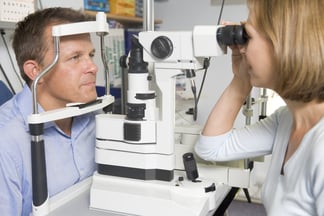We live in an era where many consider technology to be as vital as their organs. “Unplugging” and neglecting your phone for a while has become almost impossible for some. As a result, exposure to digital devices is part of our daily routine. However, it is a well-known fact that everything in excess is bad (even water!), and that includes our tech devices.

Some of us are better at restraining ourselves than others, and we don’t all react the same way to that blue light. But you’d be hard-pressed to find someone who’s never experienced a negative symptom due to their screen time, even if they didn't realize it. Downsides include tired eyes, dry eyes, discomfort, headaches, and shoulder pain. These are all results of digital eye strain and Computer Vision Syndrome.
In today’s connected world, there’s no way to completely avoid suffering from digital eye strain or Computer Vision Syndrome (CVS), but here are a few tips to help alleviate the resulting discomfort.
1. Take breaks
Staring non-stop at a computer, tablet, or phone for several hours will cause problems for your eyes. So why not take a break? Stand up from your desk for a while, actively blink or close your eyes for a moment, and move around a bit. This will benefit both your eyes and your mental health.
The 20-20-20 rule is a great rule of thumb: every 20 minutes, take a 20-second break from the computer and look at something that’s about 20 feet away.
2. Exercise your eyes
 Similar to the 20-20-20 rule, try looking at objects placed at a distance for 15 seconds, then bringing back your focus on a closer object (nothing techy), and look at that for 15 seconds as well. Repeat several times. Also try rotating your eyeballs - your body isn’t the only thing that needs exercise!
Similar to the 20-20-20 rule, try looking at objects placed at a distance for 15 seconds, then bringing back your focus on a closer object (nothing techy), and look at that for 15 seconds as well. Repeat several times. Also try rotating your eyeballs - your body isn’t the only thing that needs exercise!
3. Lubricate your eyes
Staring at a computer for hours dries up the surface of our eyes because it causes us to blink less. Dry eyes lead to irritation, which can bring about other problems like red eyes and itchiness. To help avoid this, close your eyes for a few seconds every now and then, or blink (hard) a few times. Lubricating eye drops (Refresh and Clear Eyes brands are good, Visine is NOT) are also recommended to help keep your eyes moist and healthy.
4. Get a yearly eye exam
Why wait until you feel discomfort or something serious develops to go to the eye doctor? Eye exams are as important as general health check-ups, which is why you should do both of them at least once a year (made easier with 2020 on-site!). Be sure to tell your doctor the number of hours you spend on electronic devices each day, in and outside of work.
5. Adjust your computer settings
There are a few things you could adjust on your computer and, in some cases, other devices that will mitigate digital eye strain. Try equipping your screens with anti-glare screens, make sure your computer has a high resolution display, keep your monitor bright to reduce flicker rate, and adjust options like contrast, color display, etc. to find a setting that’s easier on the eyes.
6. Try computer glasses
That’s right - glasses made specifically for computer use. They have anti-glare and anti-reflective coatings that eliminate reflections of light from the front and back surfaces of your lenses. This is one of the best ways to avoid eye strain. Additionally, avoid wearing contact lenses if you’re going to spend prolonged hours in front of a screen.
7. Update your screen
The bigger and newer the screen, the happier your eyes will be. Not only do older, wide, clunky screens take up too much space on your desk, but they’re also damaging your eyes! LCD (Liquid Crystal Displays), a layer that thin screens have, has anti-reflective surfaces, which are better for your eyes. Similarly, choosing a big screen over a small one is also better from an ability-to-focus standpoint - your eyes won't have to work as hard.
8. Check your monitor's position
 If your monitor sits too close to you, it is very likely you will feel discomfort in your eyes. It is important to keep your monitor a proper distance away from your eyes. Optimally, the computer screen should be 15 to 20 degrees below eye level - about 4 or 5 inches as measured from the center of the screen - and 20 to 28 inches from the eyes.
If your monitor sits too close to you, it is very likely you will feel discomfort in your eyes. It is important to keep your monitor a proper distance away from your eyes. Optimally, the computer screen should be 15 to 20 degrees below eye level - about 4 or 5 inches as measured from the center of the screen - and 20 to 28 inches from the eyes.
9. Rethink your lighting
The level of lighting around you should be suitable for your eyes while using a digital device. Put blinds or drapes on windows and keep your lights as bright as your device’s illumination. Too much or too little light make it a struggle for your eyes to adjust, resulting in strain and possibly headaches.
10. Keep your eyes healthy
Besides following these tips to prevent digital eye strain, simply staying healthy can go a long way as well. Eat well (especially these foods that are good for the eyes), take vitamins, and get enough rest!
Sources:
- "11 Tips for Eliminating Computer Eye Strain | Vision Source." VisionSource. N.p., 12 Aug. 2015. Web. 07 Nov. 2016.
- Ghosh, Shubham. "If Your Eyes Are Suffering From Digital Strain, Take These 10 Measures To Give Them Relief." Boldsky. N.p., 15 Oct. 2016. Web. 7 Nov. 2016.
- "Computer Vision Syndrome." Computer Vision Syndrome. N.p., n.d. Web. 07 Nov. 2016.
- "Facts About Dry Eye | National Eye Institute." National Eye Institute. N.p., Feb. 2013. Web. 07 Nov. 2016.
- Heiting, Gary. "Computer Glasses That Help Relieve Computer Eye Strain." All About Vision. N.p., Feb. 2014. Web. 07 Nov. 2016.


